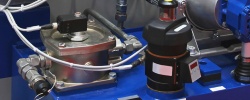 Hydraulic Accumulators
Hydraulic Accumulators
Hydraulic accumulators are devices in which potential energy is stored in the form of a compressed gas to be used to exert a force against a relatively incompressible fluid. They are used in fluid power systems for pressure maintenance/energy recapture, hydraulic axle suspension, and dampening of vibra-tions, pulsations and shocks. They shorten cycle times, increase operating life, and increase efficiency.
In modern accumulators the hydraulic fluid is separated from the gas by a piston, a diaphragm, or a rubber bladder. Today’s machinery with hydraulic drives would be unthinkable without these hydraulic accumulators—they support the oil-hydraulics within an exceptionally wide spectrum of applications. And, it is particularly important to ensure that the correct configuration of the hydraulic accumulator is specified according to the particular design requirements.
Our accumulators ;meet the requirements of a wide range of specific applications. These accumulators demonstrate outstanding characteristics for every area of application, no matter what the pressure.
Features
- High quality, long service life, less maintenance seals and diaphragms/membranes.
- Reliability in broad temperature ranges and under high pressures up to 2750 bar (40,000psi).
- Extreme burst strength and high allowable dynamic loads on the accumulator vessel due to application-specific materials
- A variety of hydraulic and gas port connections for customer-specific solutions
- A variety of global third party quality certifications available on request
Piston Accumulators
Volumes ranging from a few cubic centimeters to over seven hundred liters and with pressure stages as high as 2750 bar (40,000psi).
Can be “tailored” to meet design specifications
Diaphragm Accumulators
Operating pressures of up to 350 bar (5,000psi) and with extreme temperature requirements
Extraordinary load-carrying capacity and a low weight
Bladder Accumulators
Fast responses to extreme pressures
Available in a variety of standard volumes and pressure stages
